1. Find the equivalent capacitance of system of capacitors shown below.
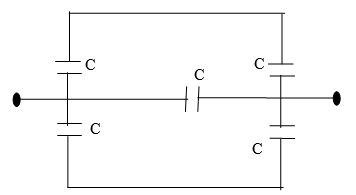
Equivalent capacitance of two capacitors each having capacitance C are connected in series.
So,equivalent capacitance = $C/2$
Therefore, the circuit can be drawn like,
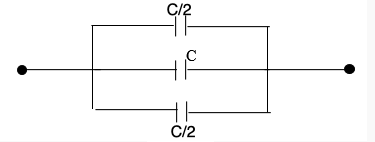
$C/2$, $C$and $C/2$are now in parallel. So the equivalent
capacitance,
$C/2$+$C$+ $C/2=2C$
- Four capacitors are connected as shown below.
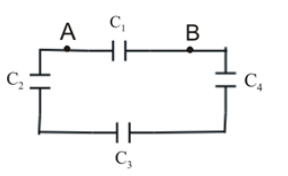
If $C_{1}=2 \mu F$, , $C_{2}=3 \mu F$, $C_{3}=4\mu F$,$
C_{5}=5\mu F$ , calculate the equivalent capacitance between $A$ and
$B$.
From the diagram, we can say that capacitors $C_{1}$ $_{ }$and series combination of $C_{2}$, $C_{3}$ and $C_{4}$ are connected in parallel.
If $C”$ is the equivalent capacitance of $C_{2}$, $C_{3}$ and $C_{4}$, then,
$1/C”=1/3+1/4+1/5$
Or, $1/C”=47/60$
Or, $C”=60/47 \mu F$
Now $C” $and $C_{1}$are in parallel.
So, equivalent capacitance, $C=C_{1}+C”=2+60/47=154/47=3.27 \mu F$
2. A point charge $q$ is located at (2, 4, 3) in xyz coordinate. Find the potential difference between A and B if A = (2, 3, 3) and B = (-2, 3, 3).
We have potential at point A,

We have potential at point B,

So,

3. A parallel plate capacitor is constructed of metal plates, each of area 0.3 $m^{2}.$ If the capacitance is $8nF$, then calculate the plate separation distance.
We have the equation for parallel plate capacitor,
$C=\epsilon _{0}A/d$
Or, $8\times 10^{-9}=8.85\times 10^{-12}(0.3)/d$
Or, $8d=8.85\times 0.3\times 10^{-3}$
Or, $d=3.32\times 10^{-4}$
Or, $d=0.00032 m=0.32 mm$
4. Refer to the below diagram. Find the resulting capacity of a plate capacitor, if the space between the plates of area S is filled with dielectric with permittivity $\epsilon $.
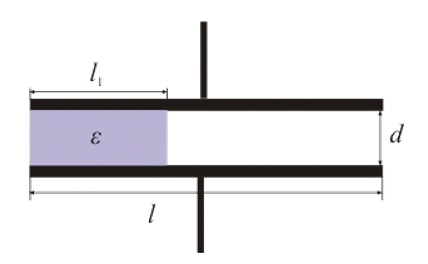
- We will replace the plate capacitor with two that are parallel. One will be filled with dielectric $l_{1}$ wide, the other will be filled with air and $l-l_{1}$wide.
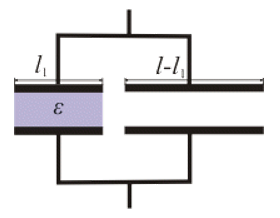
- The total capacity is $C=C_{1}+C_{2}$
- The capacity of a plate capacitor is given by, $C=\epsilon S/d=\epsilon _{0}\epsilon _{r} S/d$
- Therefore, for capacitor $C_{1}$ and $C_{2}$we get,
- $C_{1}=\epsilon _{r} S_{1}/d$ ……………….. (1)
- and $C_{2}=\epsilon _{r} S_{2}/d$ ……………(2)
- Now, we will determine the areas S1 and S2 using the lengths l, l1 and the total area of the capacitors S.The total area of the capacitor is $S= lx$, where x = width of the capacitor
- Then, $S_{1}= l_{1}x$ and $S_{2}=(l- l_{1})x$
- Or, $S_{1}= l_{1}S/l$ and $S_{2}=(l- l_{1})S/l$ (as $S= lx$
- Now, equation (1) becomes, $C_{1}=\epsilon _{r} l_{1}S/dl$
- And equation (2) becomes, $C_{2}=\epsilon _{r} (l- l_{1})S/dl$
- Therefore, the total capacity is $C=C_{1}+C_{2}$
![<math xmlns="http://www.w3.org/1998/Math/MathML"><mi>C</mi><mo>=</mo><msub><mi>ε</mi><mn>0</mn></msub><msub><mi>ε</mi><mi>r</mi></msub><mfrac><mrow><msub><mi>l</mi><mn>1</mn></msub><mi>S</mi></mrow><mrow><mi>d</mi><mi>l</mi></mrow></mfrac><mo>+</mo><msub><mi>ε</mi><mn>0</mn></msub><mfrac><mrow><mfenced><mrow><mi>l</mi><mo>-</mo><msub><mi>l</mi><mn>1</mn></msub></mrow></mfenced><mi>S</mi></mrow><mrow><mi>d</mi><mi>l</mi></mrow></mfrac><mspace linebreak="newline"/><mo> </mo><mo> </mo><mo>=</mo><mo> </mo><mfrac><mrow><msub><mi>ε</mi><mn>0</mn></msub><mi>S</mi></mrow><mrow><mi>d</mi><mi>l</mi></mrow></mfrac><mfenced><mrow><msub><mi>ε</mi><mi>r</mi></msub><msub><mi>l</mi><mn>1</mn></msub><mo>+</mo><mi>l</mi><mo>-</mo><msub><mi>l</mi><mn>1</mn></msub></mrow></mfenced><mspace linebreak="newline"/><mo> </mo><mo> </mo><mo>=</mo><mfrac><mrow><msub><mi>ε</mi><mn>0</mn></msub><mi>S</mi></mrow><mrow><mi>d</mi><mi>l</mi></mrow></mfrac><mfenced open="[" close="]"><mrow><mfenced><mrow><msub><mi>ε</mi><mi>r</mi></msub><mo>-</mo><mn>1</mn></mrow></mfenced><msub><mi>l</mi><mn>1</mn></msub><mo>+</mo><mi>l</mi></mrow></mfenced></math>](https://www.w3schools.blog/wp-content/uploads/2020/02/lessmath-xmlnshttp-www-w3-org-1998-math-mathmlgreaterless-250.png)